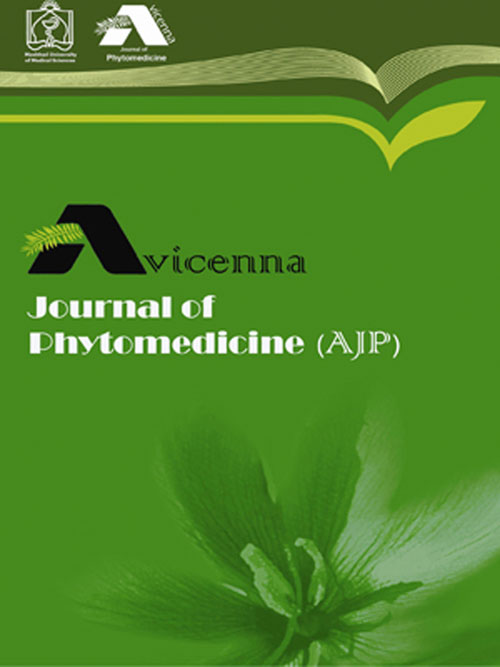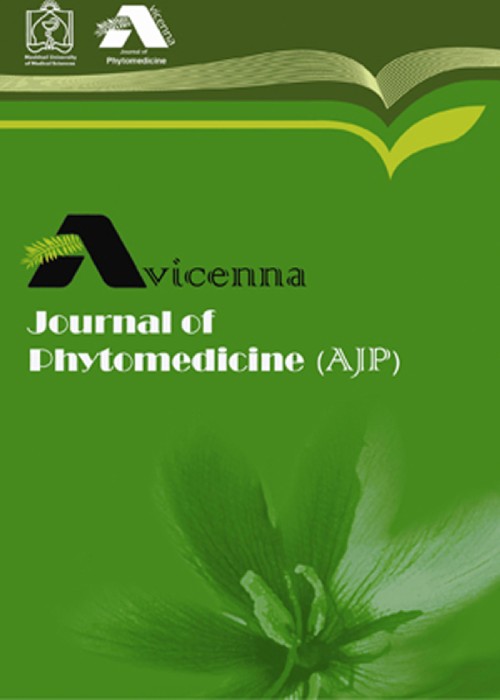فهرست مطالب

Avicenna Journal of Phytomedicine
Volume:8 Issue: 2, Feb 2018
- تاریخ انتشار: 1397/01/09
- تعداد عناوین: 9
-
-
Pages 96-113ObjectivePremenstrual syndrome (PMS) is one of the most common problems among women of reproductive age. The popularity of complementary/alternative therapies has grown in recent years, and these treatments have been more commonly used by women (48.9%) than men (37.8%). The aim of this systematic review was to assess effectiveness and safety of Iranian herbal medicines for treatment of premenstrual syndrome.MethodsPubMed, Scopus, Cochrane, and Google Scholar were searched along with SID, Magiran and Irandoc up to Dec 2017.
Inclusion criteria consist of Iranian, published, randomized controlled trials (RCTs) using Iranian herbal medicine for treatment of reproductive age women with PMS. Eventually Eighteen RCTs met the inclusion criteria.ResultsOverall, studies have shown that Vitex agnuscastus, Hypericum perforatum, Matricaria chamomilla, saffron, Curcumin, Melissa officinalis, Zataria multiflora,Wheat Germ Extract, Echinophora platyloba, Foeniculum vulgare, Valerian root extract, Citrus sinensis, Zingiber officinale andFlax seed might alleviate symptoms of PMS.ConclusionThis research demonstrated efficacy and safety of Iranian herbal medicines in alleviating PMS. Therefore, herbal medicine can be regarded as an alternative treatment for women suffering from PMS.Keywords: Herbal medicines, Premenstrual syndrome, Systematic review -
Pages 114-121ObjectiveThe methanolic extracts of Nigella sativaL. seeds (MENS) and Berberis vulgaris L.(MEBV) were investigated for treatment of Haemoproteus columbae-infected pigeons (Columba livia domestica).Materials And MethodsOne hundred twenty naturally-infected pigeons were randomly divided into four groups of thirty each. Two groups were treated separately with the extracts, while the positive and negative control groups were given buparvaquone (Butalex®) and distilled water, respectively. The parasitaemia rate was calculated in all groups before and after the experiment at four-day intervals for16 days.ResultsThe results showed a high therapeutic effect for MENS with a progressive decrease in average parasitaemia rate from 18.17% before treatment to 0.73% at the end of treatment (p0.05).ConclusionMethanolic extracts of N. sativa showed therapeutic effects against H. columbae and may be regarded as a suitable choice for further studies to develop new drugs against blood parasites, in both animals and human beings.Keywords: Nigella sativa, Berberis vulgaris, Haemoproteus columbae, Pigeon
-
Pages 122-135ObjectiveThe present investigation was carried out to evaluate the safety of an aqueous extract of the seeds of Calycotome villosa (Poiret) Link (subsp. intermedia) by determining its cytotoxicity and potential toxicity after acute and sub-chronic administration in rodents.Materials And MethodsCytotoxic activity was tested in cancer and non-cancer cell lines HeLa, Mel-5, HL-60 and 3T3. Acute toxicity tests were carried out in mice by a single oral administration of Calycotome seed-extract (0 - 12 g/kg) as well as intraperitoneal doses of 0 - 5 g/kg. Sub-chronic studies were conducted in Wistar rats by administration of oral daily doses for up to 90 days. Changes in body and vital organ weights, mortality, haematology, clinical biochemistry and histologic morphology were evaluated.ResultsThe lyophilized aqueous extract of C. villosa exhibited a low cytotoxicity in all cell lines tested with an IC50 > 100 µg/ml. In the acute study in mice, intra-peritoneal administration caused dose-dependent adverse effects and mortality with an LD50 of 4.06 ± 0.01 g/kg.In the chronic tests, neither mortality nor visible signs of lethality was seen in rats. Even AST and ALT were not affected while a significant decrease in serum glucose levels, at 300 and 600 mg/kg was detected. Histopathological examination of the kidney and liver did not show any alteration or inflammation at the end of treatment.ConclusionIn conclusion, the aqueous extract of C. villosa seed appeared to be non-toxic and did not produce mortality or clinically significant changes in the haematological and biochemical parameters in rats.Keywords: Calycotome villosa (Link Subsp. Intermedia) seed, Cytotoxicity, Acute, chronic toxicity, Clinical Chemistry, Hematology
-
Pages 136-142ObjectivePelargonium roseum Willd.(Geraniaceae) is widely grown as an ornamental plant due to its strong pleasant rose-like odor. The present study evaluates the antitrichomonal effect of P. roseum essential oil (EO) against Trichomonas gallinae both in vitro and in vivo and compares it to that of metronidazole (MTZ) as a standard antitrichomonal drug.Materials And MethodsIn vitro assays were accomplished in multi-well plates containing MTZ and EO at final concentrations of 2.5, 5, 10, 20, 50, and 100 μg/mL. In vivo assay was carried out on 40 experimentally infected pigeons receiving MTZ and EO at doses of 25 and 50 mg/kg.ResultsThe 24-hr MIC of MTZ was 10 µg/mL, while for EO it was 20 µg/mL. Treatment with MTZ 50 mg/kg after 4 days led to full recovery of infected pigeons however EO 50 mg/kg resulted in the same outcome after 5 days. No mortality or clinical side effects were seen in treated birds.ConclusionThe present study introduced P. roseum EO as a potent natural antitrichomonal agent effective against T. gallinae. Bioactive components of P. roseum can be used as potential therapeutic compounds in development of novel antitrichomonal drugs.Keywords: Pelargonium roseum, Avian trichomoniasis, Metronidazole, Trichomonas gallinae, Pigeon
-
Pages 143-151ObjectiveZiziphus jujuba stimulates the release of nitric oxide (NO). Because NO is involved in cardiovascular regulations, in this study the effects of hydroalcoholic extract of Z. jujuba on cardiovascular responses in acute NG-nitro-L-arginine methyl ester (L-NAME) hypertensive rats were evaluated.Materials And MethodsRats were divided into 6 group (n=6): 1) saline, 2) L-NAME received (10mg/kg) intravenously, 3) sodium nitroprusside (SNP) (50µg/kg)NAME group received SNP before L-NAME and 4-6) three groups of Z. jujuba (100, 200 and 400mg/kg) that treated for four weeks and on the 28th day, L-NAME was injected. Femoral artery and vein were cannulated for recording cardiovascular responses and drug injection, respectively. Systolic blood pressure (SBP), Mean arterial pressure (MAP) and heart rate (HR) were recorded continuously. Maximal changes (∆) of SBP, MAP and HR were calculated and compared to control and L-NAME groups.ResultsIn L-NAME group, maximal ΔSBP (L-NAME: 44.15±4.0 mmHg vs control: 0.71±2.1 mmHg) and ΔMAP (L-NAME: 40.8±4.0 mmHg vs control: 0.57±1.6 mmHg) significantly increased (p0.05). All doses of Z. jujuba attenuated maximal ∆SBP and ∆MAP induced by L-NAME but only the lowest dose (100 mg/kg) had significant effects (ΔSBP: 20.36±5.6 mmHg vs L-NAME: 44.1±4.0 mmHg and ΔMAP: 20.8±4.5 mmHg vs L-NAME: 40.8±3.8 mmHg (p0.05).ConclusionBecause long-term consumption of Z. jujuba extract, especially its lowest dose, attenuated cardiovascular responses induced by L-NAME, we suggest that Z. jujuba has potential beneficial effects in prevention of hypertension induced by NO deficiency.Keywords: Ziziphus jujuba, Nitro, L, arginine methyl ester, Blood pressure, Hypertension, Nitric oxide
-
Pages 152-160ObjectiveDiabetes is associated with vascular complications and impaired angiogenesis. Since angiogenesis plays a crucial role in vascular homeostasis in ischemic heart diseases, in this study, the effect of IMOD on miR-503 and CDC25 expression level which are altered in impaired angiogenesis were investigated in heart tissue of diabetic rats.Materials And MethodsForty male Wistar rats (200-250 g) were randomly classified into 4 groups: control (C), IMOD (I), diabetes (D), and diabetes (D). For induction of experimental diabetes in animals, a single dose of streptozotocin (STZ; 60mg/kg) was injected intraperitoneally. After 8 weeks of treatment with IMOD (20 mg/kg/day), heart tissue samples were removed and used for measurement of miR-503 and CDC25 expression level as well as histological studies.ResultsResults of this study showed that diabetes decreased heart tissue angiogenesis which was associated with increased miR-503 and reduced CDC25 expression levels (pConclusionThis study showed that IMOD is able to increase angiogenesis in the heart tissue of diabetic rats. The angiogenic effect of IMOD is associated with reduction of miR-503 expression and increased expression of CDC25.Keywords: Diabetes, Angiogenesis, miR, 503, CDC25, IMOD
-
Pages 161-169ObjectiveThe present study was performed to evaluate the effects of hydro-alcoholic extract of Portulaca oleracea (P. oleracea) seeds and Vitamin C on biochemical and hemodynamic parameters in cardiac tissue of rats with subclinical hyperthyroidism.Materials And MethodsForty eight male rats were divided into six groups of 8 and treated for 4 weeks. T4 group received daily injection of levothyroxine sodium (20 μg/kg) and control group was given daily injection of saline. T4-Po groups were given T4 plus 100, 200, and 400 mg/kg of P. oleracea seeds extract in drinking water daily. T4-Vit C group received T4 plus daily injection of Vitamin C (100 mg/kg). At the end of the experiment, body weight, serum free T4 level, left ventricular developed pressure (LVDP), malondialdehyde (MDA) and total thiol levels were measured.ResultsFree T4 levels were increased in all groups that were treated with T4. Weight gain was decreased in T4 and T4-Po100 groups compared to control group (pConclusionThe results showed that P. oleracea extract has a protective effect on cardiac dysfunction due to subclinical hyperthyroidism induced by levothyroxine sodium in rats.Keywords: Portulaca oleracea seeds, Vitamin C, Heart, Subclinical hyperthyroidism, Rat
-
Pages 170-178ObjectiveUrolithiasis remains a global problem. Despite the availability of numerous methods, no definite therapeutic agent has been yet introduced for the prevention or treatment of kidney stones. In this study, we evaluated the possible preventive effects of aqueous extract of Cichorium intybus L. (chicory) flowers on ethylene glycol-induced renal calculi in rats.Materials And MethodsA total of 24 Wistar rats were randomly divided into four groups and were treated for 30 days. Group A received drinking tap water, while groups B, C, and D were administered with 1% ethylene glycol for induction of calcium oxalate stone formation. Rats in groups C and D received intraperitoneal injections of the aqueous extract of chicory flowers (50 and 200 mg/kg, respectively) since the first day of the experiment. The urine volume, urine pH, and urinary levels of oxalate, citrate, calcium, uric acid, and creatinine as well as serum levels of calcium, uric acid, and creatinine were measured. After 30 days, the rat's kidneys were removed and prepared for histological evaluation of calcium oxalate deposits. One-way analysis of variance (ANOVA), followed by Tukey's test, was performed, using SPSS version 20.ResultsThe number of calcium oxalate crystals was significantly higher in group B (ethylene glycol-only treated animals), compared to group A (control), group C (50 mg/kg of aqueous extract), and group D (200 mg/kg of aqueous extract) (p0.05), and creatinine (p0.05), and urine volume (pConclusionThe aqueous extract of chicory flower (50 mg/kg) could reduce the number of calcium oxalate deposits in the urine and reduce the level of serum parameters.Keywords: Cichorium intybus L, Flower, Renal calculi, Ethylene glycol
-
Pages 179-187ObjectiveThe aim of the present study was to evaluate the possible protective effect of Plantago major (P. major) extract against doxorubicin (DXR)-induced renal inflammation in rats.Materials And Methods80 male albino rats were randomly divided into 8 groups as follows: control, DXR, Ext (extract) 600, Ext1200, dexamethasone൴, vitamin E൴, Ext600൴, and Ext1200൴. Duration of the study was 35 days and DXR was intravenously injected on the 7th day of the experiment. Tumor necrosis factor-alpha (TNF-α) production and monocyte chemoattractant protein-1 (MCP-1) expression levels were assessed in the left kidney. Serum creatinine concentration and osmolarity were determined on the 1st, 14th, 21st, 28th and 35th days of the experiment.ResultsDXR caused a significant increase in renal expression of MCP-1 and TNF-α production compared to control animals. Administration of dexamethasone, vitamin E and P. major extract significantly improved the expression of these inflammatory mediators compared to DXR group. Compared to day 1 in DXR group, serum osmolarity showed a significant increase on days 21, 28 and 35. Also, on these days, serum osmolarity in DXR group was significantly higher than that on the same days in control group. In Vit E൴ and Ext 1200൴ groups, there was no significant changes in serum osmolarity among different days of the study. However, in these groups, serum osmolarity on days 21, 28 and 35 showed a significant decrease compared to the same days in DXR group.ConclusionPresent results suggest that hydroethanolic extract of P. major protected renal tissue against DXRinduced renal inflammation.Keywords: Plantago major_Doxorubicin_Vitamin E Dexamethasone_Inflammation


